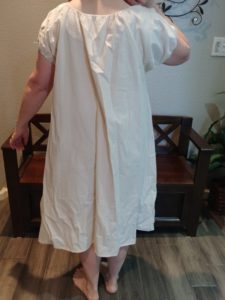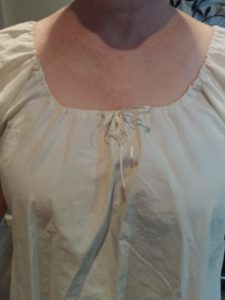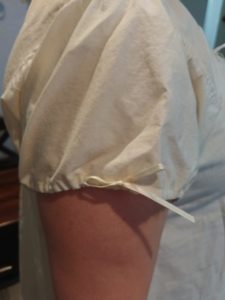 Getting dressed during the Regency seems to be quite an ordeal compared to today’s practices, but it really isn’t all that complicated. As I sit in my air conditioned office, glaring at the heat outside, it’s hard to imagine ladies would have been willing to do it. However, keep in mind that the weather in Regency England was much cooler tan it is today because they were near the end of a mini Ice Age. With such drafty houses and cold temperatures, staying warm would have required many layers of clothing.
Getting dressed during the Regency seems to be quite an ordeal compared to today’s practices, but it really isn’t all that complicated. As I sit in my air conditioned office, glaring at the heat outside, it’s hard to imagine ladies would have been willing to do it. However, keep in mind that the weather in Regency England was much cooler tan it is today because they were near the end of a mini Ice Age. With such drafty houses and cold temperatures, staying warm would have required many layers of clothing.
 The first to put on was a shift, also called a chemise. It was made of fine linen. They were almost exactly like those of the previous century, but the sleeves are shorter. A chemise provided a barrier between a woman’s body and the other layers of clothing, so the shift absorbed perspiration and was washed the most. Laundry methods used stringent soaps and boiling to achieve a high level of clean as well as to remove any stains or discoloration. Clothes could also be left out in the sun even after they were dry to be bleached clean. Since the washing process was so harsh, clothes wore out quickly and needed to be replaced frequently, therefore, shifts were usually pretty cheaply made–without embellishment. All of the shifts I saw in museums were fairly plain and unadorned.
The first to put on was a shift, also called a chemise. It was made of fine linen. They were almost exactly like those of the previous century, but the sleeves are shorter. A chemise provided a barrier between a woman’s body and the other layers of clothing, so the shift absorbed perspiration and was washed the most. Laundry methods used stringent soaps and boiling to achieve a high level of clean as well as to remove any stains or discoloration. Clothes could also be left out in the sun even after they were dry to be bleached clean. Since the washing process was so harsh, clothes wore out quickly and needed to be replaced frequently, therefore, shifts were usually pretty cheaply made–without embellishment. All of the shifts I saw in museums were fairly plain and unadorned.
 I had my shift made out of poly cotton batiste which is as close to an heirloom fabric as I could find. A fine weave muslin would have worked well, too. For my shift, we used this pattern: http://www.marariley.net/shift/shift.htm
I had my shift made out of poly cotton batiste which is as close to an heirloom fabric as I could find. A fine weave muslin would have worked well, too. For my shift, we used this pattern: http://www.marariley.net/shift/shift.htm
As you can see, my shift is fairly shapeless which is exactly what they looked like. My seamstress gathered the neck and sleeves to make it easy to fit under any kind of sleeve and neckline, but this is not necessarily how they were all made. Clothes were custom made, so historical seamstresses each probably had her own favorite pattern. If I were to do it again, I would use bleached fabric rather than unbleached, because that’s probably what a lady in the higher class would have worn. Also, I would have cut it in a little more so there isn’t so much bunching when the rest of the layers go on.
The shift is lightweight and comfortable. It is also, I might add, probably the ONLY thing worn next to the skin. There are just too many convincing arguments that state ladies of high quality did not wear drawers or pantaloons underneath. I know, it seems shocking, but sensibilities were very different in Regency England. For more information about that debate, see my blog post on the topic.
Also, even though some ladies wore nightgowns or night rails, it seems other ladies simply wore their shifts to bed rather than changing, so they served multiple purposes.
Next week I’ll discuss the next layer, the corset stays. So “stay” tuned 🙂

What did they do when they had their period?
Few primary sources mention it because it was a very private subject, but from what I’ve gleaned, women either tied something around their waist that held a folded cloth in place, or they pinned thick strips to the inside of their shifts. Some women–probably not the working class– simply stayed in bed lying on cloths. Many of the poorer classes were so malnourished that they didn’t have regular cycles. My grandmother said she nursed her babies as long as possible to keep the menses away, and she believed it helped space her children, so it’s possible women did that for centuries.